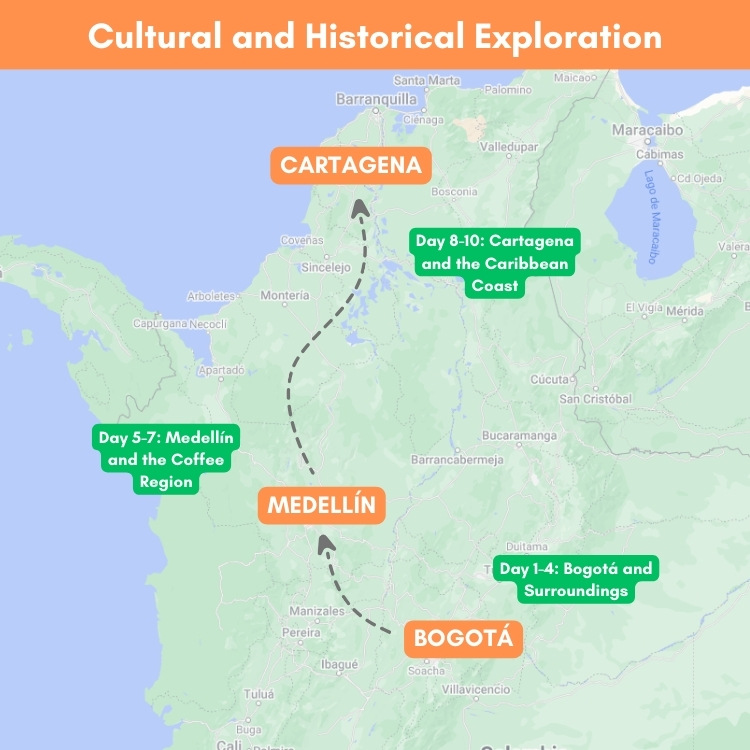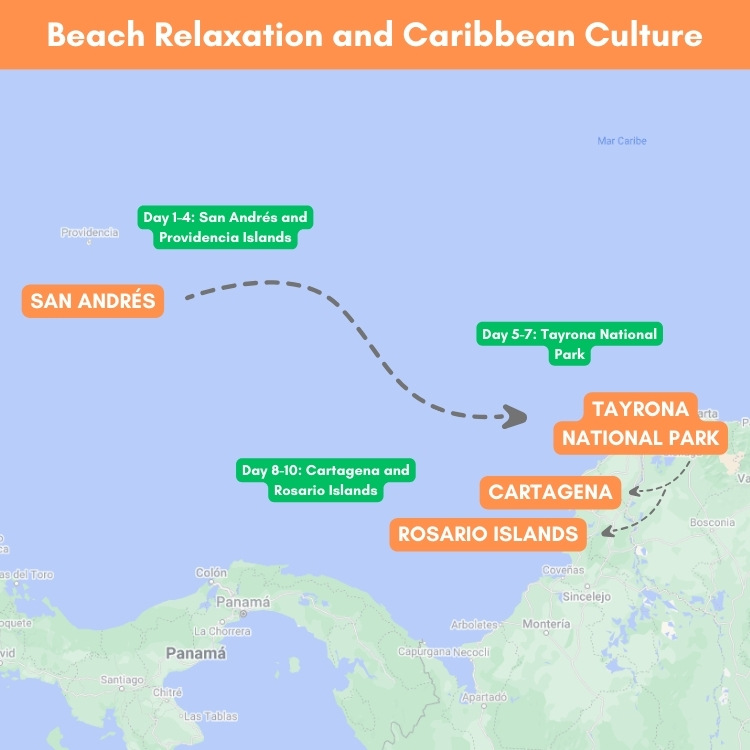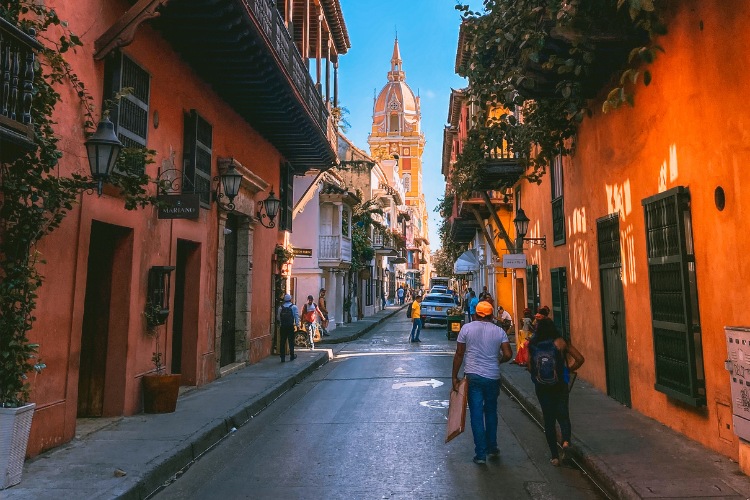Colombia is an incredibly beautiful and diverse country with so many unique experiences visitors can enjoy. In this article, I will help plan out an itinerary that showcases some of that variety while also connecting you with the varied music, culture, food and nature of the different regions.
I have lived in Colombia for over 15 years and this is what I would recommend you do if you want to focus on culture, adventure or amazing beaches.
Itinerary 1: Cultural and Historical Exploration

➡️ Day 1-4: Bogotá and Surroundings
Colombia’s capital is a great place to start to connect with Colombia’s culture and history. Situated at 2,625 meters above sea level, the huge city of over 11 million people brings together influences from all over the country while retaining a strong identity.
Bogotá has great restaurants, beautiful downtown architecture, great museums, lots of art and probably the country’s most eclectic music scene – while other Colombian cities have a defined sound, Bogotá is often more experimental and out there.
La Candelaria is the cobblestoned colonial-era city center which has impressive historic landmarks, charming narrow streets and some of the city’s most important museums. Surrounding the central Plaza Bolivar is the neoclassical Cathedral Basilica of the Immaculate Conception and Saint Peter, the home of the Colombian Congress the Capitolio Nacional and the mayor’s office situated at the Palacio Lievano. A short walk from there you will also find the Gold Museum and the Botero Museum, with work from the world-famous Fernando Botero.
The city has great restaurants, artisanal coffee shops, stylish bars and fun clubs across Chapinero, Usaquen and Zona Rosa.
An hour outside the city is the Salt Cathedral of Zipaquirá which was named the first wonder of Colombia in 2007. The incredible complex is built deep underground in a salt mine with amazing architecture and designs carved into the walls.
Close to central Bogotá you can also take the cable car or undertake a challenging, steep hike up to the Cerro Monserrate where you can visit the basilica. From here you have incredible views all across the city.
➡️ Day 5-7: Medellín and the Coffee Region
Medellin is known as the ‘city of eternal spring’ for its warm but comfortable year-round weather with brief rain storms which leave the city feeling fresh and green. Set within a broad valley alongside a river, you have amazing 360-degree views as the hillside houses continue up towards the horizon before becoming green mountains.
Visiting Comuna 13 for a guided tour is a great way to see evidence of the city’s incredible transformation. You can climb the escalator, look at the dozens of amazing graffiti pieces, listen to the freestyle rap performances, enjoy break dance routines and learn about the history of the neighborhood. My friend grew up there and he has spoken to me about living in a warzone just over 20 years ago and today it is one of the most popular tourist destinations. The views are amazing too, as the corrugated iron rooftops become downtown skyscrapers down into the valley.
The free downtown walking tour is another excellent option that works perfectly with a visit to Comuna 13. The Colombian guide will tell about the history and development of the city, taking visitors around downtown Medellin to important sites. The tour goes from the initial founding to the growth of the city, the chaos of the Escobar period and improvements since. It is a great way to learn about El Centro as it can be a little hectic and confusing in the day, then dangerous at night.
Other fun, interesting activities include Parque Explora, the botanical garden and the planetarium, which are all very close to Universidad metro station.
The music scene in Medellin is thriving with Medellin locals J Balvin, Maluma and Karol G amongst the most streamed artists on the planet. Club Perro Negro, for example, inspired this Bad Bunny song and is located in Provenza, a neighborhood that inspired this Karol G song. It is great to be at the very heart of an important music scene.
For a more peaceful and relaxing experience, you can then head to Salento in Colombia’s coffee region. The beautiful town is one of the inspirations for the Disney movie Encanto with colorfully painted houses with balconies and overhanging roofs.
A short drive away in one of the iconic old Willy Jeeps is the Cocora Valley, one of the most incredible places I have ever been. The rich green hills are filled with hundreds of remarkable wax palms, a national symbol and the palm trees in the world. The trees are amazing, some over 200 feet tall with narrow trunks.
Whilst in the coffee region you can also visit a working coffee farm and the coffee theme park Parque del Cafe in Quindio, which has amazing views and even roller coasters. You can finish your trip to the region with a relaxing spa day at Santa Rosa de Cabal which is incredibly peaceful with waterfalls and thermal spring pools.
➡️ Day 8-10: Cartagena and the Caribbean Coast
The final stop on this cultural and historic journey around Colombia has to be Cartagena.
With the historic center set within 16th-century walls filled with colonial squats, cobbled streets, churches and beautiful old houses, every corner you turn in Cartagena’s old town has something fascinating to discover. You can enjoy the sunset on top of the walls with a cocktail at Cafe del Mar and then head to Cafe Havana, a 1950s Cuban style bar with live salsa music and amazing decor.
Just outside of the old town is San Felipe de Barajas which is a great historic fort with amazing views across the city. You can get a guided tour which will tell the turbulent history of Cartagena which includes fighting off attacks from famous British pirate John Hawkins and privateer, essentially a pirate with a permission note, Sir Francis Drake.
The Getsemani neighborhood which is just outside the old town is another area which has been rejuvenated by art, culture and food. Once an area to avoid, it is now a popular tourist spot with great art and guided tours of the squares and churches.
Itinerary 2: Adventure and Nature

➡️ Day 1-3: Amazon Rainforest Adventure
With regular flights from Bogotá to Leticia it is surprisingly easy to head deep into the Amazon rainforest for an unforgettable experience. The town of Leitica has a population of around 50,000 and sits at the tri-border with Brazil and Peru. It is very easy to visit 3 South American countries in a single day and it is quite surreal to walk down the street and notice signs change from Spanish to Portuguese.
At sunset every day thousands of parakeets come from the surrounding jungle to nest in the central square. Before settling down for the night they quickly fly above the heads of the locals in large circles squeaking. It is a very strange, impressive scene.
While nature can come to you in Leticia, you definitely should head out to explore. You can take a day trip in a boat up the Amazon which will include pink dolphins, an island full of friendly monkeys and the biggest lily pods in the world. There is also the chance to visit local indigenous communities to learn about their culture and way of life.
If you are feeling really adventurous you can take a night trek through the Amazon with a guide where you can come across a wide variety of animals including snakes, large spiders and crocodiles.
➡️ Day 4-6: Hiking in the Andes
To get a real sense of Colombia’s amazing diversity, you can quickly go from canoeing along the Amazon River surrounded by dense jungle to climbing a snow-capped mountain with amazing views. There are a number of great hiking spots along the Andes mountain range in Colombia with Cocuy and Los Nevados two great options.
The Cocuy National Natural Park has the largest glacier mass in Colombia with over 25 snow and ice-covered peaks across 2 mountain ranges running across 30km. The area is a sacred place for the Uwa Indigenous community. There are a number of trails available such as Ritacuba, which is 13.8km around the Rictacuba glacier, or the Laguna Grande which is 21.2km to the beautiful mountain lake in the center of the park.
Los Nevados National Natural Park is in the coffee region with snow peaks, important wetlands and spectacular views. The altitude can be challenging but the amazing nature and sense of achievement make all the effort more than worthwhile.
➡️ Day 7-9: Adventure Sports in San Gil
San Gil in the department of Santander has a population of just over 50,000. It was founded in 1689 and it has become a popular tourist destination, known as Colombia’s adventure capital.
The surrounding areas offer perfect spots for rafting (grade 1 to 5), kayaking, hiking and caving. Tour groups leave for Parque el Gallineral, which covers 10 acres along the Rio Fonce, or Parque Nacional del Chicamocha which is 1 hour from the town. Chicamocha has a museum, trails, rafting, paragliding and a unique cable car which crosses the canyon.
The town has a traditional feel with a nice central square but also has some fun nightlife when the sun goes down. A great base to explore the nature in the region and enjoy some unique experiences.
Itinerary 3: Beach Relaxation and Caribbean Culture

➡️ Day 1-4: San Andrés and Providencia Islands
San Andres is an island 775 km from the Colombian mainland and 191 km from Nicaragua in Central America. The fascinating, beautiful island has had a long and interesting history but today is a very popular beach destination for Colombians and foreign visitors.
With amazingly clear blue waters that are said to shine in 7 different colors with long, perfect beaches dotted with palm trees, it is a great place to relax. The locals have their own dialect which combines English, Jamaican patois, Spanish and African languages such as Igbo and Kwa.
Providencia is just North of San Andres and was once an English puritan colony which was taken from the Spanish with cannons still left scattered around from the 1629 battle. Once again, amazing beaches and rich coral filled with fish.
➡️ Day 5-7: Tayrona National Park
A 30-minute bus ride from the city of Santa Marta is the Tayrona National Park which covers 150 square kilometers of jungle, beach and sea. Within the park, there are hundreds of bird species, monkeys and even jaguars wandering around.
It is around 50 minutes to walk from the main entrance to the most popular beaches for swimming, Cabo San Juan and Piscina. Along the way, you will trek through dense forest, climb up and down rocks, pass through mangroves and across beautiful beaches.
Taryona is an excellent option if you want nature and incredible beaches all with close access to a fun, friendly city.
➡️ Day 8-10: Cartagena and Rosario Islands
Colombia’s most popular beach destination is Cartagena and with good reason. The beautiful coastal city has amazing history, lots of culture, delicious seafood, amazing bars and lots of fun clubs. You can explore the historic old town, taking in all the sounds and sights.
In terms of beaches, Bocagrande is very convenient as it is close to popular hotels and walking distance from the old town but it isn’t the best option. There are lots of very pushy sellers while the sand isn’t as soft and the sea isn’t particularly welcoming.
Boats leave regularly every morning from Cartagena to the Rosario Islands, an archipelago of 27 small islands covering 20km. The largest, suitably named Isla Grande, is still small enough to walk across in around 40 minutes and there are no motorized vehicles allowed. There is a lot of variety as some have boat parties, hotels and beach clubs while others are very peaceful and deserted.
